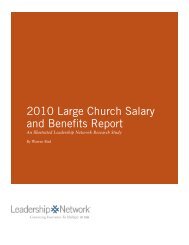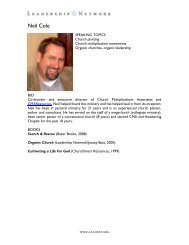ARE WE A PEOPLE AT HALF TIME? - Leadership Network
ARE WE A PEOPLE AT HALF TIME? - Leadership Network
ARE WE A PEOPLE AT HALF TIME? - Leadership Network
You also want an ePaper? Increase the reach of your titles
YUMPU automatically turns print PDFs into web optimized ePapers that Google loves.
“The pastoral megachurches that have been growing so very fast in<br />
the U.S. since 1980 are surely the most important<br />
social phenomenon in American society in the last 30 years.”<br />
— Peter F. Drucker<br />
Until the early 1980s, all but the first of these<br />
now outdated assumptions were close enough<br />
to reality to be useful. In this essay I will show<br />
why every one of these assumptions is now<br />
either wrong, out-of-date or both.<br />
The Discipline of Management<br />
We today tend to think of management<br />
as business management.<br />
Management writers, management<br />
practitioners and the laity do not even<br />
hear the word “management”; they automatically<br />
hear “business management.”<br />
It is therefore important to assert—and to<br />
do so loudly—that management is not<br />
business management, any more than, say,<br />
medicine is obstetrics.<br />
There are, of course, differences in management<br />
between different organizations—mission<br />
defines strategy, after all,<br />
and strategy defines structure. But the differences<br />
between managing a chain of<br />
retail stores and managing a Roman Catholic<br />
diocese are amazingly fewer than either retail<br />
executives or bishops realize.<br />
www.leadnet.org<br />
The differences are mainly in application<br />
rather than in principles. The executives of all<br />
these organizations spend, for instance, about<br />
the same amount of their time on people<br />
problems, and the people problems are<br />
almost always the same.<br />
So whether you are managing a software company,<br />
a hospital, a bank or a Boy Scout organization,<br />
the differences apply to only about<br />
10% of your work. This 10% is determined by<br />
the organization’s specific mission, its specific<br />
culture, its specific history and its specific<br />
vocabulary. The rest is pretty much<br />
interchangeable.<br />
Why is it important to break down the artificial<br />
distinction between business and nonbusiness<br />
organization Because the growth<br />
sector of a developed society in the 21st century<br />
is most unlikely to be business. The<br />
growth sectors in the 20th century in developed<br />
countries have been in nonbusiness—in<br />
government, in the professions, in health care,<br />
in education. In the 21st century that trend is<br />
going to continue with a vengeance.<br />
So the nonprofit social sector is where management<br />
is today most needed and where systematic,<br />
principled, theory-based management<br />
can yield the greatest results fastest.<br />
People pay little attention to the<br />
succession process, though it<br />
is, in fact, the ultimate test of<br />
good management.<br />
0 2<br />
The One Right Organization<br />
From the very beginning, more than a century<br />
ago, the study of organization has rested on<br />
one assumption: “that there is or must be a<br />
single ‘right’ form of organization.” That onesize-fits-all<br />
idea persists today.<br />
By now, however, it should have become clear<br />
that there is no such thing as the one right<br />
organization. There are only organizations,<br />
each of which has distinct strengths, distinct<br />
limitations and specific applications. It has<br />
become clear that organization is not an<br />
absolute. It is a tool for making people productive<br />
in working together. As such, a given<br />
organizational structure fits certain tasks in<br />
certain conditions and at certain times. Yet<br />
there are universal principles of organization.<br />
One is surely that an organization has to be<br />
transparent. People must know and understand<br />
the organizational structure in which<br />
they are to work. This sounds obvious—but it<br />
is far too often violated in most institutions,<br />
even in the military.<br />
Multiple Organizational Structures<br />
The executive of the future will require a toolbox<br />
full of organizational structures. He will<br />
have to select the right tool for each specific<br />
task. That means he or she will have to learn<br />
to use each of the tools and understand which<br />
one works best for each task. And when, in<br />
the performance of a task, he or she<br />
should switch from one kind of organization<br />
to another.<br />
This analysis is perhaps most needed for<br />
the currently politically correct organization:<br />
the team.<br />
It is generally assumed today that there is<br />
only one kind of team—the jazz<br />
combo—where each participant does his<br />
or her own thing but together they make<br />
great music. Actually there are at least half a<br />
dozen—perhaps a full dozen—very different<br />
teams, each with its own area of application,<br />
each with its own limitations and difficulties,<br />
and each requiring different management.<br />
Here are some examples of teams:<br />
The old-fashioned functional team is the kind<br />
that prevails in department stores. The different<br />
departments—buyers, displayers, promotion<br />
and advertising, selling—do not work<br />
together, and none of their members ever do<br />
the task of a member of another function,<br />
except in a rare crisis.<br />
The advantage of this team is that each member<br />
can be trained in a particular strength, as<br />
are hitters, pitchers and catchers on a baseball<br />
team. And each member can be measured<br />
and judged against clear and specific<br />
goals. The weaknesses are rigidity, slowness in<br />
www.leadnet.org







